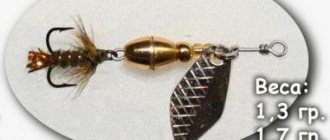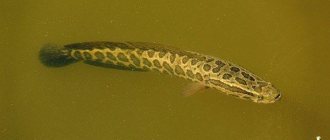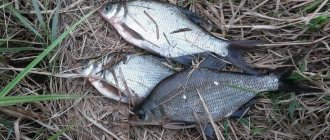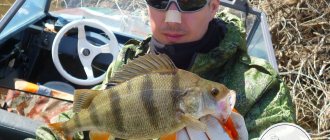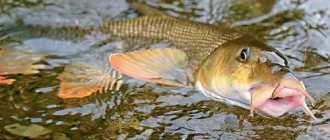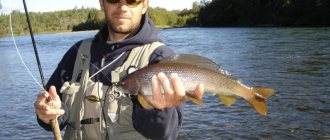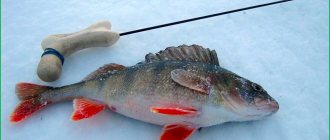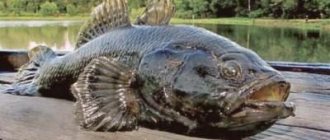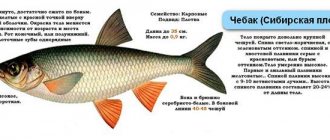Rotan is a small predatory fish that lives mainly in reservoirs with stagnant water. Its lifestyle can be called parasitic, since rotan very often eats eggs and fry of other fish species, thus maintaining its own existence. Cannibalism is also very developed among rotans, when large individuals eat smaller ones.
A rotan is also distinguished from other fish by its high vitality. This predator survives in water bodies that are dry or, on the contrary, frozen to the very bottom, and calmly tolerates water pollution and a lack of oxygen in it.
Information about rotan:
- Resembles a bull.
- It reaches 25 cm in length.
- Weight up to 700 grams.
- Lifespan is up to 5 years
- Considered a trash fish
- Very durable
- Lives in standing water
- Delicious white meat
What to catch rotan with
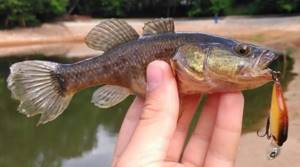
In summer, rotan is caught using a wide variety of baits of animal origin and small artificial baits.
The most effective baits for rotan: worms, maggots, pieces of meat or lard, finely chopped live bait.
As for artificial baits, among them the primacy belongs to small spinners and silicone baits. In general, baits of almost all types are used; the main thing is to provide amplitude intense play, which irritates the rotan and provokes it to attack. In winter, this fish is caught using balancers, various jigs, and meat baits.
Where to catch rotan on the first ice
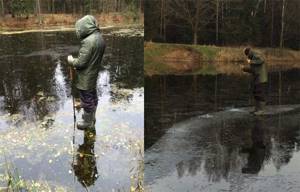
Moving around the reservoir, I notice that today there are fewer bites in deep places, and the bulk of the fish stays where the layer of water under the ice is about half a meter, among the grass. Therefore, I conduct further searches in places with such depths. Today he doesn’t take it right away, but about five minutes after the hole is cut - apparently, the shallow depth has an effect. But then several small rotans come up at once - this is clearly visible in the turbid water - and attack the lure one by one until only one or two of the most cautious ones remain and have already been hooked more than once.
Spoons for catching rotan in winter
On one of the holes, the spinner is lowered next to a stone, from behind which a gloomy-looking light yellow rotan the size of a galosh is revealed (albeit, a very child’s size). And in fact, a sleeper chasing a bait looks gloomy and concentrated from above - apparently because of its close-set small eyes on its wide head.
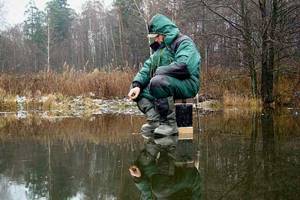
Trying not to scare off the monster, I smoothly move the spoon and raise the spoon slightly higher. Obviously interested, the rotan at the same pace, practically without moving, floats up behind the spoon, lazily opens its mouth right under the hole, sucks in the bait and rushes to the side. A blow, and the spoon flies out of the mouth straight onto the ice. It's a shame, the rotan is clearly a trophy one. All further attempts to seduce him led to nothing. What can be done, it is clear that this is why he has grown to such a size that he is careful in choosing food.
Now for some reason I don’t feel like catching small things anymore, the first hunt is over, the excitement has passed, suddenly my feet, dressed not yet for the winter season, are frozen, the wind has become colder - in short, it’s time to go home.
In three hours of active fishing, I caught a couple of kilograms of green, yellow, black, swamp fish with spots, brown speckled fish, which I don’t really want to call “a cross between a ruff and a frog.”
Where to catch rotan
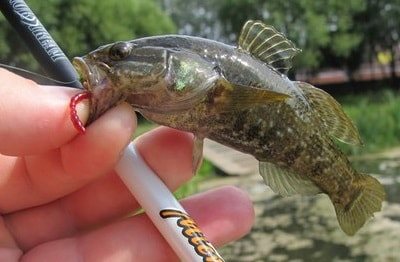
The favorite habitats of rotan are areas with an abundance of tall vegetation in standing reservoirs. Since this fish is distributed unevenly throughout the reservoir, you always need to actively search for it. It often happens that in one place you can pull out each hook at once in one trip, but in another you can’t catch anything in an hour and a half of fishing.
Diet, nutrition
Rotans are aquatic predators
. If initially the fry use zooplankton for food, then after a while small invertebrates and benthos serve as food for the fish. Adults actively eat small species of fish, leeches and newts, as well as tadpoles. Golovachs are able to feed on the eggs of other fish and even carrion. The species has excellent vision, thanks to which it sees prey from afar, after which it slowly, “dashes”, approaches the victim, working at this moment exclusively with its ventral fins. The movements of a hunting rotan are very slow and calm, and the fish itself is characterized by intelligence, which allows it to make non-trivial decisions in difficult situations.
This is interesting!
In rotan, cannibalism is widespread in the form of large fish eating smaller individuals belonging to their own species, due to which the bait is swallowed very deeply during fishing.
In small bodies of water, rotan firebrands very quickly become numerous, and therefore are capable of completely and quite easily exterminating almost all representatives of any other species of non-predatory fish. Rotans are very voracious and often have absolutely no sense of proportion in their diet. When the fish is completely full, it becomes almost three times thicker than its usual state. Sated rotans quickly sink to the bottom, where they can sit for up to three days, trying to completely digest the food.
Fishing for rotan in winter
Winter fishing for rotan begins with searching for promising places where this fish is located. On the first ice, rotan often hangs out closer to the shore and bites extremely actively.
The thicker the ice becomes, the further the fish will move from the shore, preferring, first of all, deeper areas with aquatic vegetation.
After sudden and severe cold spells, rotans gather in flocks and most often descend into deep holes. However, this behavior is observed mainly only in large bodies of water. In small lakes and ponds, where the water can often freeze to the very bottom, rotans also gather in flocks, but then they simply freeze in the ice and spend the entire winter in this state, and in the spring they return to an active lifestyle.
Catching large rotan: useful recommendations and personal observations
If previously the trophy of many novice fishermen was minnow and perch, today, I think, it will be the ubiquitous sleeper. We can safely say that rotan has now populated almost all of our lakes, and it is settling in there thoroughly. As you know, sleeper is a predator, and such that as soon as it gets into a body of water, within a few years the populations of other fish species begin to decline sharply. Rotan will not miss the opportunity to eat the eggs of other fish, fry, and can even attack its relatives. Among other things, this fish can safely be classified as a hardy species that survives where fish of other species are simply not able to live and reproduce. Surely you yourself have witnessed how a rotan caught for several hours suddenly comes to life in a basin of water, not to mention the fact that many fishermen claim that a rotan frozen into ice and taken out of it comes to life. Many fishermen have the opinion that rotan is a trash fish that should not be paid attention to.

I used to think so too, and, to some extent, it is so. But, if you manage to get to a normal place and catch a dozen or two rotans weighing 300 grams or more, you begin to feel differently about this fish. By the way, it should be noted that catching a large rotan is not difficult: in open water it stays mainly near coastal areas (they catch it with perch float tackle, with a spinner), and in winter, catching it on the first ice is a most exciting activity. We are not talking about jigs here; for rotan, this is too delicate tackle. A regular vertical spoon or a balancer with a planted piece of meat (you can even rotan) is much more suitable. At one time, I was somewhat frightened by the appearance of rotan: blackish (with shades interspersed with yellowish spots, which are especially pronounced on the sides, the belly is lighter), a huge head, everything is somehow awkward. But that was all until I forced myself to try fried rotan. It seemed to me that it is in no way inferior in taste to the same perch, for example.
Read: Rotans came to the rescue during the lack of biting
As for the tackle for rotan, we have already noted - most often, this is a float tackle, a vertical spoon (both in summer and winter), and a side nod. The favorite bait is a worm; rotan often grabs an empty hook, especially if you give it a game. In the summer, my friends and I catch rotan near the shore, fishing the edge of aquatic vegetation and windows. If there is rotan, he will certainly take it. True, there are days when for some reason you only come across small rotan, which sometimes manages to swallow the hook so much that it’s easier to cut it off (don’t forget to find a hook at home so you don’t accidentally eat it) and not waste time while fishing on the process of releasing it. By the way, many circle fishermen use rotan as live bait, arguing that rotan on a hook can remain active for a very long period of time. Well, pike eat it quite well. I myself have not tested rotan as live bait, so I cannot confirm or refute what was said above. By the way, rotan is a very good way to practice your reaction. Everything is clear here, you should miss the bite, you will have to tinker with removing the hook, which in a short period of time can go almost “to the tail” of the rotan. As for biting rotan, everything is not so simple here either. Sometimes he takes sharply and actively, it is impossible to miss a bite. But it also happens differently: the float will tremble slightly a couple of times and that’s it... no more changes. And after some time, trying to recast, it suddenly turns out that the rotan is already on the hook. I will say on my own behalf - this is a guaranteed reason to change the leash (or you will have to gut the fish in order to free the tackle).
Read: Rotan
And finally, I would like to note that catching rotan is an exciting activity. This fish almost always bites, and often you come across truly amazing specimens that will delight any gourmet. In my practice, I both fried this fish and dried it - it turns out very tasty.
Good luck with your fishing.
PS An important point in favor of rotan: catching it does not require any special gear or skill, the main thing is the presence of, at a minimum, a float rod (in the open water season), worms, and, well, attentiveness, speed of reaction... Fishing with rotan helps take a break from everyday life, as you fully concentrate on the process...
Tactics for catching rotan in winter
In the winter season, a good fishing tactic involves systematically drilling holes in the direction from the shore to the middle of the pond. Having drilled the first “well” near the shore, we retreat 2-3 m and make another hole, then another one after a similar distance, and so on. In winter, rotan is quite passive, and only grabs what floats “in front of its nose.” But when at least one of the holes hits the flock, an outcome is quite possible in which in a couple of minutes the catch will already amount to a dozen rotans.
Technique for catching rotan on first ice
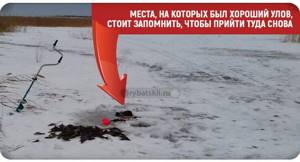
Remember the holes where the bite was
Having arrived at the reservoir, make a series of holes in promising places. As a rule, when fishing for rotan on the first ice, you can not let the holes “rest”, but start fishing right away. Active fishing with a jig or spinner will show the points with the greatest number of bites. Remember these holes. The fact is that rotan often moves along the same “paths”. Leave a silent successful hole alone for half an hour or an hour and check later, the fish will be there again.
While fishing, note where there are more fish today - near the shore or further towards the middle, at what depth, near what shelters, where the best bite is observed. This will help in further search for fish. If a catchable hole does not have any “special features,” try drilling an area within a radius of 5–10 meters and look for fish. Despite the uniform distribution of rotan in the reservoir, in some places its concentration may be higher than in others. This is more noticeable the larger the body of water.
☸ Catching rotan in the spring with a float rod
After the opening of reservoirs, the gluttony of firebrand fish remains the same as in the first half of March. It continues to stay under the shore, among the remains of vegetation, driftwood and other rubbish, so it remains accessible even to those who do not have a boat. The appetite of the fished object is not affected by changeable spring weather; it continues to greedily pounce on the bait offered by the fishermen, not being afraid of either thick fishing lines or large hooks. In open water it is also caught with simple, often primitive gear without thin leashes or other tricks.
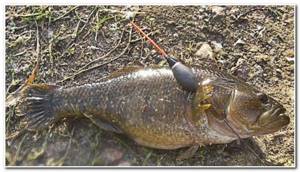
⚓ As a rule, this is an ordinary float fishing rod, consisting of the following elements:
- rods with a length of 4 to 5 meters (if the bite is good, you will have to constantly hold the rod in your hands, so it is worth paying attention to such a characteristic as weight);
- monofilament fishing line with a thickness of 0.16 mm (you can use a thinner monofilament, but this will not affect the bite, but the risk of tearing it after a hook will increase);
- a float of any shape and design (for catching rotan, many prefer to use barrel-shaped models, thanks to which it is possible to determine its approach to the bait in diverging circles earlier);
- a shotgun weight that holds the bite alarm in the working position;
- a hook with a long shank (this is easier to pull out of the predator’s mouth).
As you can see, all the components are quite affordable, so catching rotan in the spring with a float rod will not require any special expenses. You can even take a bamboo rod if you have one lying around somewhere in the garage. A leash is not needed at all, the object being fished does not react to the color of the fishing line, so any one will do. The only thing you have to fork out for is an extractor. Without it, pulling the hook out of the mouth of an insatiable fish will be problematic.
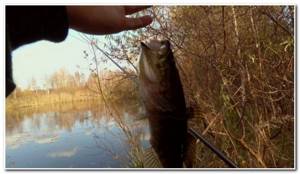
⚓ What to catch
You can catch rotan with a float rod using maggots, worms, cut meat or fish... in general, using everything that was used in March when fishing from the ice. When the sun gets really hot and the water temperature rises to 13-15 degrees, the diet of this meat-eater will expand. From a certain point (from about mid-May), rotan will begin to be interested in vegetable attachments: corn, pearl barley and other cereals. Artificial baits like silicone worms can also be used. True, they will have to be coated with aromatic substances, since this “gourmet” is not interested in food without smell.
Some fishing websites recommend that fishermen rub artificial baits with raw meat, but if you have such a product on hand, then why are they needed? It is enough to cut off a piece and catch the first fish, and from it you will already get a dozen or one and a half delicious baits. Rotan cannot be called a cannibal, since he does not eat his fellow creatures whole, but in parts - with great pleasure.
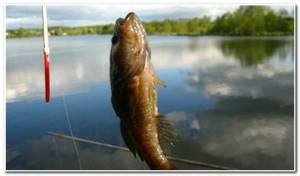
⚓ Fishing tactics
The tactics for catching rotan on a float boils down to finding its site. Most often, accumulations can be found in heavily overgrown and silted areas. He has nothing to do on the clean bottom, since there are no living creatures there. The most promising spots will be windows among the dry stems of aquatic plants, as well as the boundaries of grass and clear water, where he ambushes bugs and small invertebrates. In this respect, rotan is similar to pike. The toothy predator is known to react to the movement of the prey. It's the same with the bighead. If there are no bites at a promising point for a long time, you just need to drag the bait a little along the bottom and the float will immediately go under the water.
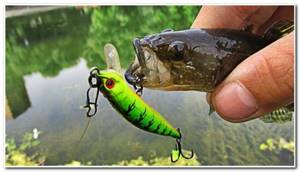
☸ Catching rotan in the spring on the last ice
Like most other species, firebrand behaves sluggishly in the dead of winter, but with the first thaw it begins to become active and at the border of winter and spring it is already well caught. The appetite of this fish is such that its instinct of self-preservation is almost completely turned off. That is why delicate fishing rods and thin equipment are not needed to catch rotan in early spring from the ice. Any tackle will do, even the roughest. For example, a hard fishing rod with the same hard nod, a 0.2 mm fishing line, a sinker and a large hook. Rotan lives up to its name; carp hooks can easily fit into its mouth. There is no need to install thin winter fishing lines (0.08 mm, 0.1 mm), especially since frosts can still persist in March, and it is very difficult to work with them.

